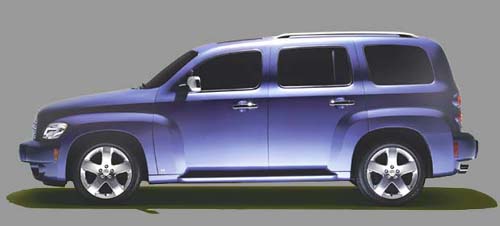2006 Chevrolet HHR Crossover/Wagon
The 2006 Chevrolet HHR appears to have followed Bob Lutz, GM’s Vice Chairman, over from Chrysler, where it first saw life as the PT Cruiser. That’s not necessarily a bad thing.
The HHR, which I have been told stands for Heritage High Roof, comes to market after another retro inspired model, the Chevrolet SSR pick-up. The HHR has fared much better in the marketplace than the niche market SSR. Chevy has just bumped production numbers of the 1940s-styled sedan while other domestic models are meeting with less willing buyers.
To begin with, the most obvious feature on the car is the wagon-like styling, inspired by the original 1949 Chevy Suburban. The nifty bodywork has been placed on GM’s new compact car platform, the Chevrolet Cobalt, which is much more rigid and responsive than the Sunfire/Cavalier it replaced. The high roof wagon profile translates into a spacious roomy cabin with an abundance of headroom. Front buckets seats provide for an upright and elevated view of the road. As you look through the windshield, you notice the dashboard and adjoining door panels have been fabricated with an attractive, but at the same time, monotonous plastic that could use a bit more detail. That being said the fit and finish were excellent and the storage cubby between the two front seats on the dashboard was a handy spot to store items needed on a regular basis.
There were a couple of pet peeves. One was that the window lift switches have been moved to the central panel running down the middle of the dashboard towards the floor mounted console. Too much attention is required to raise and lower the windows not to mention the physical reach in order to lean over and make contact with the lift switches.
Locating the manual shifter between two bucket seats with fold away arm rests is another ergonomical faux pas. The shifter stick is relatively short for a sportier look, but with the arm rests down, I found it difficult to shift properly and apply the parking handbrake, which made contact with an armrest when applied. Opting for an automatic transmission will sidestep this concern.
The interior is a pretty versatile layout with seats flipping and flopping to raise interior cargo capacity from 23.8 cubic-feet to 55.6 with the rear seats down. The front passenger seat back also folds forward to create a flat deck that allows longer items to rest flat inside the cabin.
Aside from the minor issues listed above, the HHR was a great commuter. Cornering is on par with most compact sedans and straight line tracking was good with a pliant and comfortable ride.
The little wagon was fitted with GM’s wonderful 2.2 litre, 4-cylinder Ecotec engine, producing 143 hp. Our tester was equipped with a Getrag 5-speed manual transmission which made for a pleasant driving experience. Yes, you won’t need driving gloves and you won’t be mistaken for a street racer but that certainly isn’t GM’s target market for this boulevard cruiser. An optional 2.7 litre Ecotec engine produces 171 HP with its variable valve timing. The larger motor adds more performance to the HHR, but you’re still not blowing the doors off much else. Its “high roof” adds roughly 300 pounds to the weight of a Cobalt or Pursuit, so the extra weight pretty much offsets the extra horsepower.
Safety is an odd concept for automotive buyers. We all read reports about how one car is safer than the other, yet we continue to buy SUV’s with higher roll over occurrences and resist paying for safety features. Which leads me to my surprise on the HHR; Antilock brakes are a $600 option, which in all fairness includes Electronic Traction Control as part of the package. GM has learned that consumers are more likely buy a car if the $600 is spent on fancy wheels than on ABS. Do not blame GM, manufacturers are in the business of selling cars and generally respond to consumers; they are simply giving the public what they want, choice. For the safety minded, the $600 is reasonable and effective insurance.
Fuel economy was reasonable through a combined city/highway cycle with consumption running around 9.5 litres per 100 kms or roughly 26 miles per US gallon of fuel.
Our two kids loved the attention the car received and were excited about driving in the “cool looking blue car”. Overall, what you see is what you get with the HHR, a fun little car that performs well enough to be a delightful family commuter. For under $20,000, many cars are worthy of consideration but the HHR, sets itself apart with its funky styling and is worthy of a second look. A base model HHR LS starts at $18,995. Our test vehicle was priced at $19,595, with the optional $600 anti-lock brakes.
Copyright © Auto Reviews Online 2016 | Privacy & Terms of Use | info@autoreviewsonline.com | Website by Brolly Media

